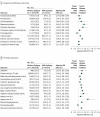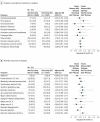Association Between Pregnancy and Perinatal Outcomes Among Women With Epilepsy
- PMID: 28672292
- PMCID: PMC5710333
- DOI: 10.1001/jamaneurol.2017.1310
Association Between Pregnancy and Perinatal Outcomes Among Women With Epilepsy
Abstract
Importance: To date, few attempts have been made to examine associations between exposure to maternal epilepsy with or without antiepileptic drug (AED) therapy and pregnancy and perinatal outcomes.
Objectives: To investigate associations between epilepsy in pregnancy and risks of pregnancy and perinatal outcomes as well as whether use of AEDs influenced risks.
Design, setting, and participants: A population-based cohort study was conducted on all singleton births at 22 or more completed gestational weeks in Sweden from 1997 through 2011; of these, 1 424 279 were included in the sample. Information on AED exposure was available in the subset of offspring from July 1, 2005, to December 31, 2011. Data analysis was performed from October 1, 2016, to February 15, 2017.
Main outcomes and measures: Pregnancy, delivery, and perinatal outcomes. Multivariable Poisson log-linear regression was used to estimate adjusted risk ratios (aRRs) and 95% CIs, after adjusting for maternal age, country of origin, educational level, cohabitation with a partner, height, early pregnancy body mass index, smoking, year of delivery, maternal pregestational diabetes, hypertension, and psychiatric disorders.
Results: Of the 1 429 652 births included in the sample, 5373 births were in 3586 women with epilepsy; mean (SD) age at first delivery of the epilepsy cohort was 30.54 (5.18) years. Compared with pregnancies of women without epilepsy, women with epilepsy were at increased risks of adverse pregnancy and delivery outcomes, including preeclampsia (aRR 1.24; 95% CI, 1.07-1.43), infection (aRR, 1.85; 95% CI, 1.43-2.29), placental abruption (aRR, 1.68; 95% CI, 1.18-2.38), induction (aRR, 1.31; 95% CI, 1.21-1.40), elective cesarean section (aRR, 1.58; 95% CI, 1.45-1.71), and emergency cesarean section (aRR, 1.09; 95% CI, 1.00-1.20). Infants of mothers with epilepsy were at increased risks of stillbirth (aRR, 1.55; 95% CI, 1.05-2.30), having both medically indicated (aRR, 1.24; 95% CI, 1.08-1.43) and spontaneous (aRR, 1.34; 95% CI, 1.20-1.53) preterm birth, being small for gestational age at birth (aRR, 1.25; 95% CI, 1.13-1.30), and having neonatal infections (aRR, 1.42; 95% CI, 1.17-1.73), any congenital malformation (aRR, 1.48; 95% CI, 1.35-1.62), major malformations (aRR, 1.61; 95% CI, 1.43-1.81), asphyxia-related complications (aRR, 1.75; 95% CI, 1.26-2.42), Apgar score of 4 to 6 at 5 minutes (aRR, 1.34; 95% CI, 1.03-1.76), Apgar score of 0 to 3 at 5 minutes (aRR, 2.42; 95% CI, 1.62-3.61), neonatal hypoglycemia (aRR, 1.53; 95% CI, 1.34-1.75), and respiratory distress syndrome (aRR, 1.48; 95% CI, 1.30-1.68) compared with infants of unaffected women. In women with epilepsy, using AEDs during pregnancy did not increase the risks of pregnancy and perinatal complications, except for a higher rate of induction of labor (aRR, 1.30; 95% CI, 1.10-1.55).
Conclusions and relevance: Epilepsy during pregnancy is associated with increased risks of adverse pregnancy and perinatal outcomes. However, AED use during pregnancy is generally not associated with adverse outcomes.
Conflict of interest statement
Figures


Comment in
-
Further Actions Are Needed to Prevent Maternal Deaths From Epilepsy.JAMA Neurol. 2018 Jan 1;75(1):132-133. doi: 10.1001/jamaneurol.2017.3621. JAMA Neurol. 2018. PMID: 29204600 No abstract available.
-
Study suggests that pre-existing maternal epilepsy increases the risk of adverse perinatal outcomes.Evid Based Nurs. 2018 Jul;21(3):77. doi: 10.1136/eb-2018-102882. Epub 2018 Mar 16. Evid Based Nurs. 2018. PMID: 29549116 No abstract available.
References
-
- Viinikainen K, Heinonen S, Eriksson K, Kälviäinen R. Community-based, prospective, controlled study of obstetric and neonatal outcome of 179 pregnancies in women with epilepsy. Epilepsia. 2006;47(1):186-192. - PubMed
-
- Tomson T, Battino D. Teratogenic effects of antiepileptic drugs. Lancet Neurol. 2012;11(9):803-813. - PubMed
-
- Koo J, Zavras A. Antiepileptic drugs (AEDs) during pregnancy and risk of congenital jaw and oral malformation. Oral Dis. 2013;19(7):712-720. - PubMed
MeSH terms
Substances
LinkOut - more resources
Full Text Sources
Other Literature Sources
Medical

